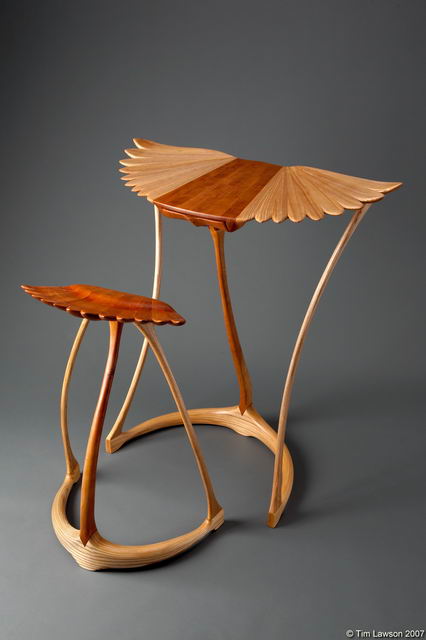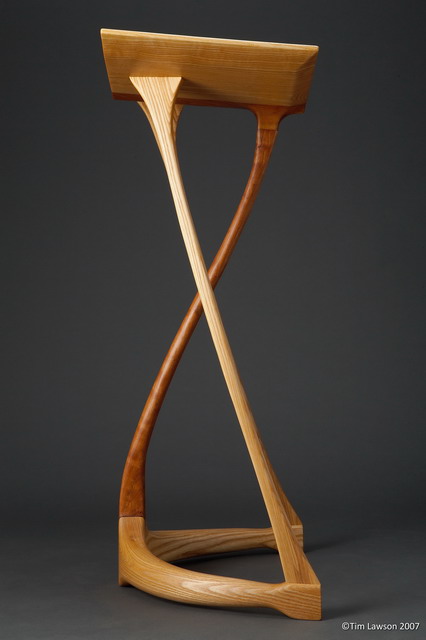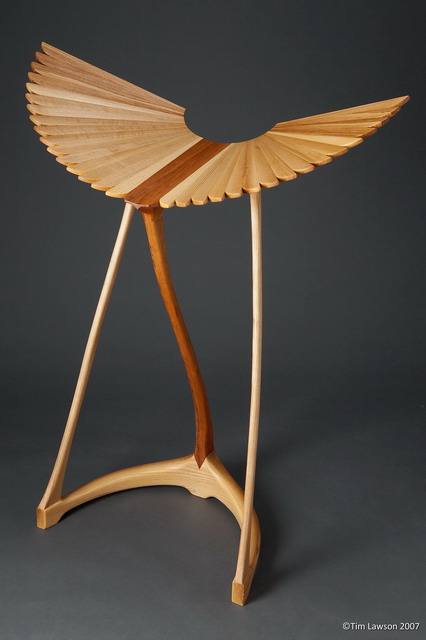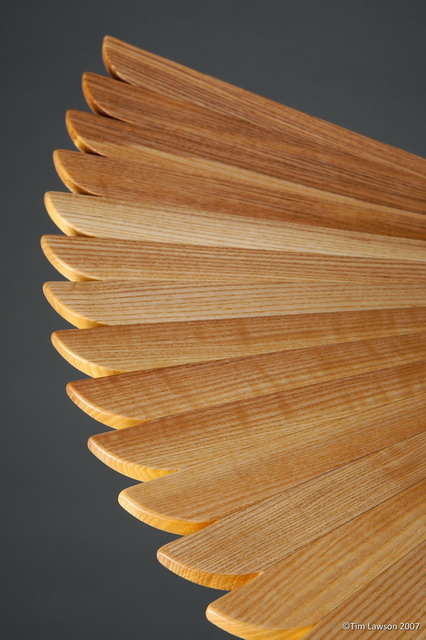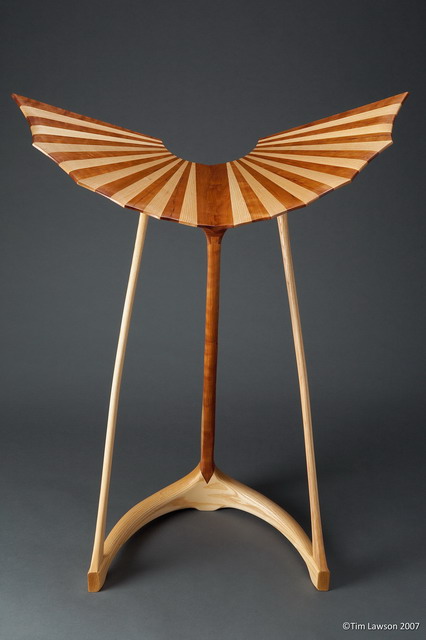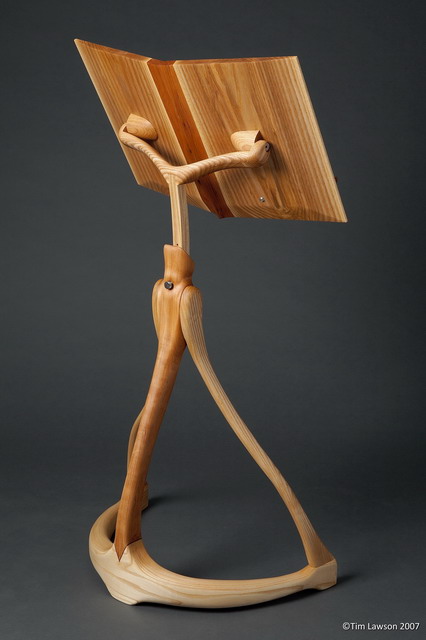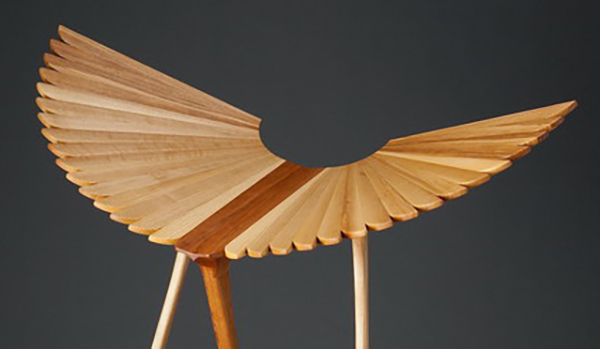
Winged elements above graceful curvilinear lines are the hallmarks of Tim Lawson’s work. His pieces easily straddle the line between sculpture and furniture. However, creating beauty does not always translate into quick sales, and he admits that one problem he is facing is that his work generates more flattery than specie.
“What I make is in a very difficult niche,” Tim laments in his gentle British accent. “One woman came up to me at a show, pointed to my winged lectern and said ,’You make me believe there is a god.’ But while I’ve had a lot of good reaction from people who love my work, few appear willing or able to actually buy my pieces.”
So instead of sticking solely to building, he and a pair of fellow woodworkers are opening a new woodworking school. In a sense, it is a return to his roots, since his father was a teacher, but getting there took him on a rather convoluted trail through several countries and careers.
“I grew up in the U.K. in Brighton,” Tim recounted, “and did some woodworking between the ages of 11 and 14 while I attended grammar school. After graduating from Liverpool University with a degree in geology, I went to work for the British Geological Survey gathering information which was used to compile a map of the distribution of rock types. I did that for six years, then took a two-year hiatus to travel.
“I got on the Trans-Siberian Express to Japan in 1981 and traveled around Japan visiting temples. I was fascinated by the Japanese culture. From there, I headed south and west around the Pacific Rim to Korea, Taiwan and Hong Kong. I was fortunate enough to get a visa to go into China, which was extremely difficult to do at that time. The guy in front of me was told there were no visas available, then when I stepped up, I was given one. I think the reason was that I was suitably deferential, something I learned in the Far East, and that helped me get chosen.
“I spent about six weeks traveling around China, which was an incredibly surreal experience. At that time, there was very little trade between the two countries. I spent about three and a half days just wandering around the Forbidden City, then did a grand loop around the country. I ended up in Australia and worked there for a year as a geologist. Once my visa expired, I returned to the U.K. and changed careers, ending up in the software business working for Lotus. They transferred me to Cambridge, Massachusetts in 1988.
“Once here in the U.S., I met my wife, who was working at Harvard at the time. We bought a house in the Boston area, and it had a basement, the perfect spot for a shop. From a good friend, who owned a door company which got into some trouble, I inherited a mess of woodworking tools. That got me hooked, and I took an evening course in woodworking, which in turn made me realize the limitations of my inherited tooling. By 1997, I had upgraded to top-notch equipment.
“In August 2000, I quit my job and applied to the Center for Furniture Craftsmanship in Maine for a 12-week intensive course. By then, I had started falling in love with Shaker furniture, and intended to learn to make simple, elegant rectilinear furniture. It was a wonderful course that opened me to many different artists, styles and methods. Somewhere in the middle of that course, I changed my focus toward curves. I realized that I was really inspired by winged creatures. The bases of my pieces try to capture the grace and curvature of a swan, something that I observed at our house in Massachusetts, which was on the Assabet River.
“With a shop full of tools and lots of inspiration, but no jobs, I put my resume back into the high-tech market. Meanwhile, my wife, who was born and raised in Seattle, was getting anxious to return home to be able to look after her parents. We looked around and fell in love with Port Townsend, a picturesque Victorian seaport with a strong arts and crafts community, and moved there toward the end of 2004. This time, I rented a shop space separate from our home, intending for the first time to make my living as a furniture maker.
“It did not work out quite as planned. I gave myself a year and a half to create my portfolio, and ended up spending six months trying to build a freestanding double helix display unit. It never did come to fruition, possibly because the joinery required an accuracy that I was not capable of at the time. I decided to fall back on my other designs, including one I had started at the Center.
“The first piece I did was the Amperstand, which I made for my wife. High on my list of things I wanted to learn was coopering, and that influence shows up in some of my later work. The Bat Stand, for example, and the Winged Amperstand and music stand are all made with coopered wings. Since there are no iron rings containing my coopered segments, I had to figure out a different way to adhere the staves. I settled on a combination of epoxy and vacuum bag clamping.
“I submitted a number of pieces to various galleries and shows and managed to garner a few awards, including being a finalist for the Niche Award from the American Craft Council. It seems I have had a lot more success being recognized for my talents than for selling them, and although I was gaining recognition, I was not managing to sell my own designs. However, I was taking on commissions for other woodworking jobs.
“One of the benefits of living in Port Townsend was being able to network with the local woodworking community. A bunch of us got together and formed ‘The Splinter Group,’ which puts on an annual woodworkers’ show here in town. There I met John Marckworth. I had earlier met Jim Tolpin, a close neighbor who lives just around the corner. We three started talking about how this was a wonderful location for a woodworking school. We were convinced there was demand, and tested it by running a series of woodworking classes in rented space at Fort Worden in the fall of 2007. Eighty students attended the six classes.
“The mission of Fort Worden has been changing lately toward becoming a lifelong learning center. To that end, we set up shop there and plan to stay. At the moment, we three founders are teaching at the school, but we hope to expand and bring in more local teachers. For the nonce, getting the school off the ground has been a full-time job, though I hope to be able to spend more bench time soon.”
Tim is somewhat sanguine about his lack of selling success, and quite hopeful and expectant about the school for a number of reasons. “Perhaps that is why I am better as part of an organization than working as an individual. I draw a lot of strength from collaboration, and this school is an amazing one. We are very complementary in our skills; it is almost unbelievable. The synergy makes the school work.”
Since doing good work and selling it are not the same thing, it is probably for the best, and certainly to the advantage of his students, that Tim is focusing on the school. As he puts it, “I think I am a better teacher than I am a marketer of my work.”
